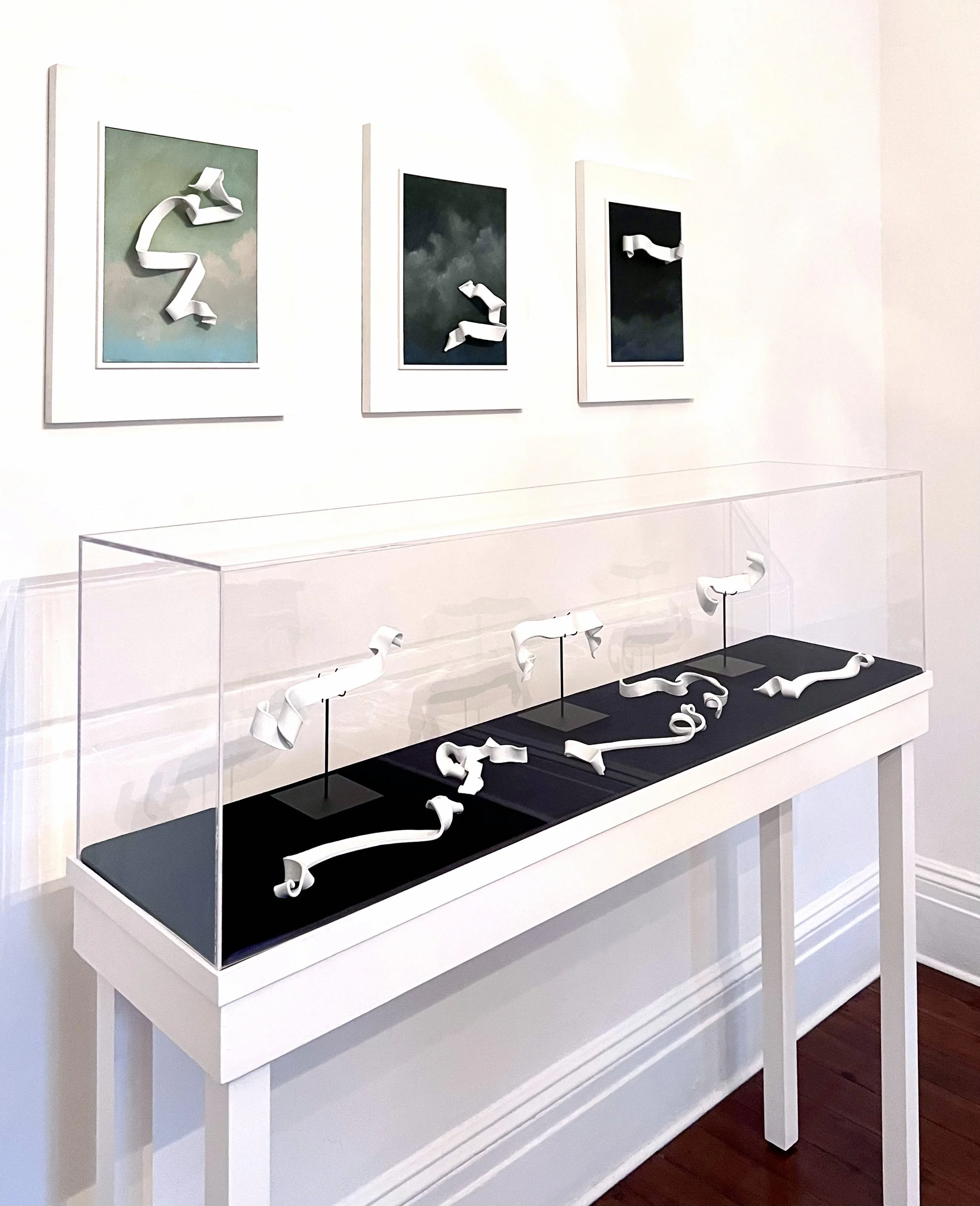Work in Progress: Banderoles, the Apophatic Sky, and the Memorializing Artifact
by Raymond E. Mingst
September 22 — November 24, 2024
Installation View
Untitled (Banderoles), digital print, 20 X 16 inches, 2024
The sky serves as a place to focus contemplation, to seek answers, guidance, and solace. Our skyward gaze frames our most profound moments of existential contemplation. Henry David Thoreau’s reflections in Walden evoke this constitutive human experience—"The stars are the apexes of what wonderful triangles! What distant and different beings in the various mansions of the universe are contemplating the same one at the same moment?" This meditation on the sky resonates with the way in which we dream of connections that extend beyond our immediate reality. Similarly, in Walt Whitman’s “When I Heard the Learn’d Astronomer,” the speaker turns away from scientific explanations to "look up in perfect silence at the stars," finding more in the act of simple gazing than in intellectual analysis. The sky is the place where unanswered questions linger.
At the heart of my work is an attempt to articulate what is missing as a result of the HIV/AIDS pandemic, a tragedy that decimated a generation of creative gay men—artists, writers, thinkers, collectors, appreciators. Their absence is a void in our cultural history, a devastating fracture. Banderoles, traditionally depicted as scroll-like elements used in art since the medieval period to display text or speech, appear in my current work and float without text. They reference an empty space, and an attempt to hear from the cosmos which returns only silence.
These uninscribed banderoles find echoes in Laurie Maguire’s exploration of blank spaces in This Page Intentionally Left Blank; or, the Apophatic Page. Maguire writes about the way early modern typography saw blank spaces as creative opportunities, places where meaning could be filled in by the reader. In my work, the blank banderoles create space for the viewer to inscribe their own grief, to contemplate what has been lost in silence. The banderole, devoid of words, mirrors our inability to fully grasp or articulate the magnitude of our losses.
Furthermore, Sarah Stanbury’s examination of medieval banderoles as touchable objects in her essay “Bearing The Word: Speech Scrolls, Touch, and the Carthusian Miscellany” in Literature and the Senses adds another layer to the understanding of my work. Stanbury notes that banderoles often emerge from the hand, not the mouth, indicating that they are not merely carriers of speech but also objects of tactile engagement. In my work, this idea is made literal—the banderoles are sculpted from clay, tangible objects. Their tactile quality reinforces the idea of reaching out, of seeking contact with something beyond ourselves—the search for meaning in the wake of devastation. The hand that holds the banderole becomes a stand-in for our inherent desire to grasp what is lost, to make the intangible tangible.
These banderoles are intentionally untethered from speech. While traditionally associated with the delivery of words, my banderoles remain mute, a physical manifestation of the unspeakable—what can no longer be said because the voices have been silenced. Yet, they remain present, floating in the gallery space or hovering over paintings of the sky, signaling their presence in the aether.
The sky is ever a symbol of the divine, a place to which we look for guidance, signs, or signals. But for those of us grieving immense loss, the sky is also a repository for prayers and unanswerable questions. My banderoles inhabit the tension between hope and silence, between the desire for communication and the stark reality of absence.
Working in the shadow of the HIV/AIDS pandemic I am constantly aware of the legions of creative individuals whose lives were cut short. The pandemic didn’t just take lives; it fractured networks, erased potential collaborations, and left an artistic lineage that is forever incomplete. My work with banderoles is, in part, an attempt to honor that loss—to give form to the silence and create a space where absence is acknowledged. It is also a way of engaging with the present, of grappling with what remains, and of reaching out to the cosmos, even when no clear answers are forthcoming.
This work in progress, and these banderoles, serve as meditations on loss, language, and our need to communicate—even when what we most need to say has no words. They represent a signal in the aether, an attempt to connect with an erased history, and the hope that, somehow, the echoes of those lost voices might still be heard.


